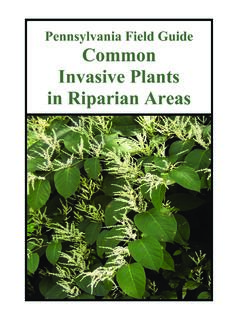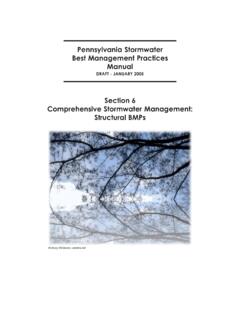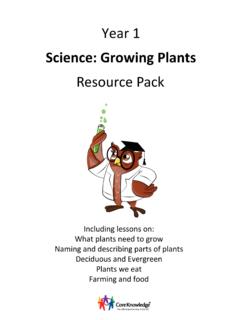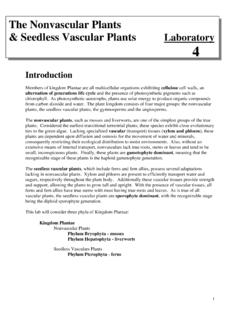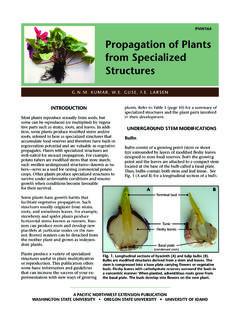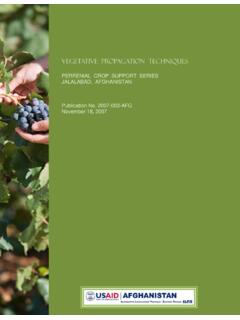Transcription of Pennsylvania Field Guide Common Invasive Plants in ...
1 Pennsylvania Field Guide Common Invasive Plants in Riparian Areas Caution: Be careful when using pesticides as a method to control Invasive Plants . Make sure any products used are approved for the specific site location of the Invasive plant; especially if the Plants being controlled are located near water. Always follow directions and heed all precautions on the labels. Additional Resources: Illustration Credits: Expect as noted, all illustrations by Jan Caulfield Parts, Types and Positions of Leaves illustration courtesy of PA. Department of Conservation and Natural Resources, Bureau of Forestry Photographic Credits: All photographs in this publication were used with the permission of the photographers.
2 Except as noted, all photographs taken by Deborah J. Rudy and Rebecca J. Wertime, Alliance for the Chesapeake Bay. Photographs of Glossy Buckthorn and Winged Euonymous downloaded with permission from October 2003, Invasive and Exotic Species of North America. Copyrighted by the University of Georgia. Photograph of Garlic Mustard courtesy of The Nature Conservancy. The views expressed herein are those of the author and do not necessairly reflect the views of EPA, DEP, or any of its subagencies. Funding provided by: The Pennsylvania Department of Environmental Protection through Section 319 of the federal Clean Water Act administered by the Environmental Agency Printed May 2004.
3 Introduction Introduction Invasive plant species are Plants introduced from outside of an ecosystem with characteristics that help them dominate and limit the diversity of species within the invaded area. Their threat lies in an ability to spread aggressively and reproduce prolifically, easily out-competing native Plants for light, space and nutrients. Introduction of an Invasive plant species can quickly result in a reduction of native plant species and of habitat for native wildlife. Once established, Invasive Plants are extremely difficult to control and restoration of the natural ecosystem can require large amounts of financial and labor resources.
4 Early detection and rapid response is the best and most cost effective approach to controlling Invasive plant species. Exotic Invasive plant infestations can also threaten the pollution prevention functions of riparian vegetation because an infestation typically results in diminished values, such as soil holding capacity, nutrient uptake capacity and habitat. The Plants featured in this Field Guide have been selected as some of the most significant Invasive plant species found in riparian and wetland areas in Pennsylvania . Species were selected after surveying conservation professionals working to restore and maintain native riparian systems in Pennsylvania .
5 The TheAlliance Alliance forfor thethe Chesapeake Chesapeake BayBay is is a regional, a regional, non-profit non-profitorganization organizationthat thatbuilds buildsconsensus consensusand and fosters fosters partnerships partnershipsforforthetheprotection protectionandandrestoration the ofrestoration the Bay andofits therivers. Bay and its rivers. Glossary Achene: Small, dry fruit with single seed. Aril: Fleshy, exterior covering of some seeds. Biennial: Herbaceous plant with two year life cycle. Bract: Modified leaf arising below a flower or inflorescence.
6 Drupe: Fleshy or pulpy fruit with hard stone containing a single seed. Heartwood: Central, dark colored portion in a tree trunk. Leaf juncture: Connection between leaf and stem. Lenticel: Small gas-exchange openings in the cork of a woody stem. Ligule: In grasses, ring of hairs at the junction between sheath and blade. Lobe: Rounded segment of a leaf, forming part of a larger structure. Midrib: Central vein of a leaf. Node: Segment of stem to which leaf is attached. Noxious Weed: A plant determined by Pennsylvania law to be injurious to public health, crops, livestock, agricultural land or other property.
7 Ocreae: Pair of stipules joined in a tubular sheath around the stem. Palmately: Leaves with four or more lobes radiating from a single point, resembling a human palm with outstretched fingers. Pappus: Feathery whorl covering the fruit/seed for dispersal by wind. Perennial: Herbaceous plant living more than two years. Petiole: Stalk between the leaf and stem. Rhizome: Creeping underground stem. Rosette: Circular cluster of leaves radiating from the stem at ground level. Sapwood: Outer, light colored region of secondary xylem. Stipule: Small, leaf-like growth at the base of a leafstalk.
8 Vegetative reproduction: Asexual reproduction, using vegetative tissues. Xylem: Water conducting tissue of Plants . Leaf Str uctur Structur ucturee Herbaceous Common Reed Phragmites australis Identification Plant Tall perennial rhizomatous grass Hollow stems Occasional multiple branches Grows 3-16 feet in height Habitat Brackish and freshwater marshes Wet and riparian areas Leaf Narrow with stiff, sharp points Smooth edges Grows alternately on top half of stem Up to 12 inches long by 1 inch wide Connection between stem and leaf (ligule). has a ring of fine, silky hairs Flower Purplish-brown plumes fading to tan Blooms in late June Reproduction Primarily vegetative through rhizomes Seed spread by wind Look-alik Look-alikee Plants Common reed is similar in appearance to Giant reed (Arundo donax), another non-native grass that is considered to be Invasive in some areas.
9 The plumes of Arundo are covered with soft, whitish hairs. Contr ol Control Common Reed is very hard to control once established. Cutting done near the end of July for several years to diminish plant vigor has proved successful. Cut shoots should be removed to prevent resprout. Application of an aquatic form of glyphosate has also been found to be successful and should be done after the plumes have developed. Research into biocontrol is being conducted. Herbaceous Garlic Mustard Alliaria petiolata Identification Plant Cool season biennial herb First year plant is a low evergreen rosette Second year Plants grow 2-3 feet tall and develop single or multiple branched stalks Second year growth begins in early spring and dies back by late June Habitat Shady to partly shady areas Prefers moist soil.
10 Leaf Heart or triangular shape with sharply toothed edge Measures 1-3 inches long and wide Arranged alternately on stalk Gives off garlic odor when crushed Flower Small, white with four petals Clustered at the top of stalks Blooms April-May in Pennsylvania Seed Shiny, black, in slender erect pods Matures in May Seed developes even on cut flowering plant Reproduction Prolific and persistent seeds Look-alik Look-alikee Plants First year Plants are similar in appearance to other rosette-forming Plants such as violets (Viola sp.), White avens (Geum canadense) and Bittercress (Cardamine spp).
